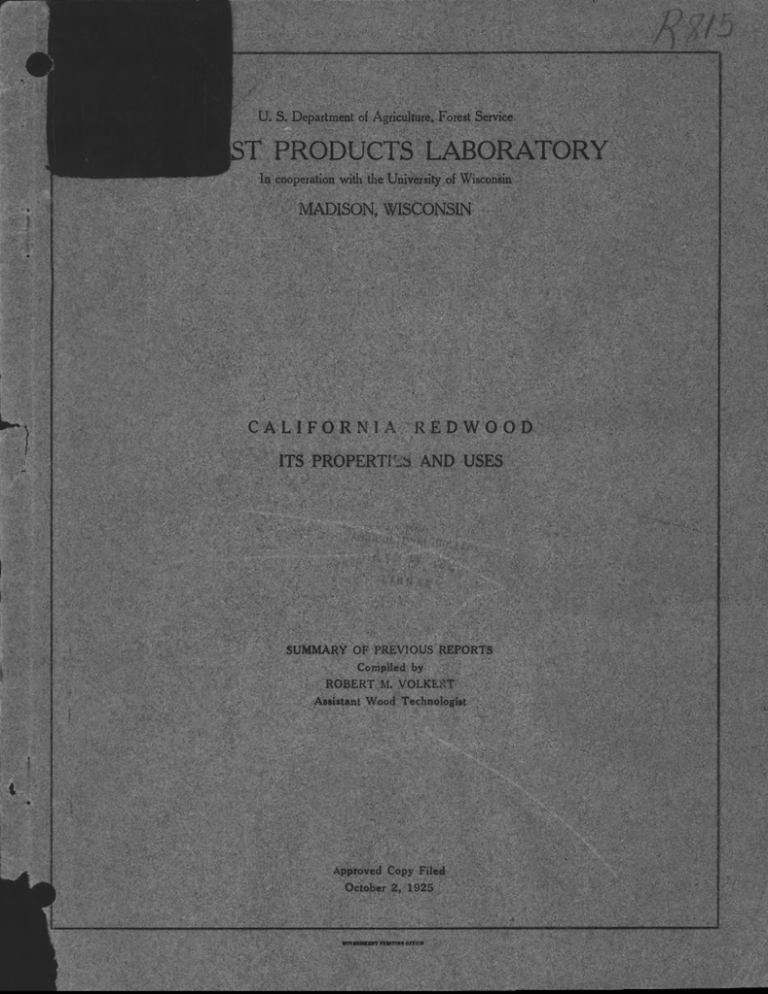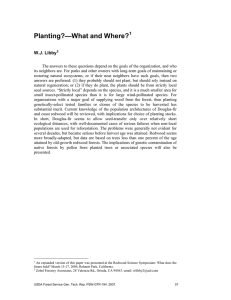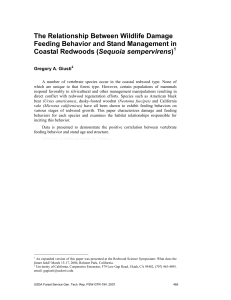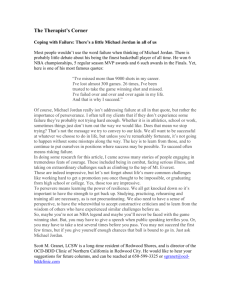ST PRODUCTS LABORATORY MADISON, WISCONSIN CALIFORNIA REDWOOD ITS PROPERTY AND USES
advertisement

U. S. Department of Agriculture, Forest Service ST PRODUCTS LABORATORY In cooperation with the University of Wisconsin MADISON, WISCONSIN CALIFORNIA REDWOOD ITS PROPERTY AND USES SUMMARY OF PREVIOUS REPORTS Compiled by ROBERT M. VOLKEz Assistant Wood Technologist Approved Copy Filed October 2, 1925 eT nsmaomaa CITI E ORNIA REDWOOD ITS "HO P RTIES USES Properties Yechani cal The outstanding feature developed by the few tests that have been made on redwood is the variability of the wood with regard to strength properties. The seat of the difficulty in obtaining reliable data lies in variation in density or specific g ravity found in the species. In order to secure data on mechanical properties which would be representative of the species it would first be necessary to have a thorough knowledge of the density variation. Then by the selection of material of typical densities it would be possible to make strength tests which would be conclusive with respect to the density-strength relation and hence truly representative of the species in its whole range of strength values. Information as to the strength of redwood of various densities would unquestionably be of more value to the user than stren g th data based on 'average" density. Also, it • would enable the producer to select material adequate for certain purposes and thereby eliminate, to a lar g e extent, an important source of complaint on the part of the consumer. Without such a selection of material it is difficult for the consumer interested primarily in the strength of the wood to p lace proper reliance upon any given - lot of it. R81 • Tests have shown that some specimens of redwcod P very hard, with a strength about equal to that of oak or longleaf pine, while others are li g ht, soft, and brash. Consequently the information nov' available on redwood, i , in g eneral, quite erratic, which makes it difficult to draw a fair comparison with certain other important species and to derive values truly representative of the species. On account of the variability in density of the material tested at the Laboratory nothing more than a general indication of the stren gth of redwood as compared with other species can be given. Judged by the average density of the material tested, redwood compares favorably with the following species: 1. Strength as a beam or post Port Orford cedar Dou g las fir of the coast type Western larch Loblolly and shortleaf pine Red maple 2. Hardness Port Orford cedar Dou g las fir of the coast type ' r estern larch Loblolly pine Shortleaf pine Tamarack Black ash Cucumber tree White elm Red. gam Oregon maple Silver maple Sycamore 2815 - 2 - 411 3. Shock resisting ability Southern cypress Dou glas fir of the Mountain type Grand fir Noble fir Western white pine Red sruce White spruce Red alder • Chestnut Cottonwood 4. Stiffness Southern cypress White fir Lodgopole pine Pitch pine Rod spruce White spruce Red alder Aspen Slippery elm Red gum Oregon maple Magnolia Sycamore Another series of tests on redwood of different average density might load to entirely different speciescomparisons. The shrinkage of redwood should be g iven special mention on account of its peculiar variability. Indications from the most r e cent tests are that the average shrinkage of the wood in both ra1lI1 and tangential directions is relatively low as compared with most species. Redwood is generally • pronounced longitudinal shrinkage, end several instances of abnormal shrinkage in the lengthwise reputed to have a direction have come to the Laboratory. This R815 attention of the Forest Products characteristic probably applies _3_ to occasional boards, but it can not be said to hold for the species as a whole. 7owever, a lot of lumber carefUlly seasoned to the moisture content at which it is to be used, should give no trouble as the shrinkage has taken place before the lumber is put into use. Physical Properties Seasoning - As in the case of its other properties, some variability exists in the ease of kiln drying of redwood. The variation is due in a very large measure to differences in moisture content, the heavier wood in the butt logs containing a much greater percentage of moisture than the wood from logs higher up in the tree. Redwood, as a rule, requires more time in the kiln than the pines, fir, and many other coniferous species, but if reasonable care be exercised it can be dried with a very low degrade. It is advantageous to se g regate the lumber according to moisture content and charge into separate kilns. Ability to stay in place - Investigations and servations by the Forest Service indicate that in ability to stay in place redwood is comparable to Dou glas fir, western hemlock, southern yellow pine, western white pine, Sitka s p ruce, basswood, and others. Redwood stays in place better .than eastern hemlock, western larch, black cottonwood, California black oak, and sycamore, but not so well as white pine, p robably the premier wood in this respect. R815 - 4 - Workability - No exhaustive studies to determine the workability of Our native woods have been conducted by the Forest Service, but a considerabl amount of information has been collected from observations in woodworkin g shops and from the experince of others. Workability is a composite property of wood texture, hardness, density, composition, and other qualities. Although redwood falls in the same general class with eastern white pine, yellow poplar, sugar pine, the cedars, western white pine, western yellow pine, basswood, and chestnut„as regards workability, it ranks slightly below the first three and slightly higher than the others. It is better in this property than most of the other commercial woods. Nail-holding ability - The ability of wood to resist the withdrawal . of nails or screws depends to a large extent on its specific gravity (density), its hardness, strength in fibre, texture, greater or less tendency to split, and other properties. Because redwood is larer in density and certain other properties thdn many other woods, naturally its ability to hold nails is considerably less. Redwood is therefore grouped with those mods havin g the least nailholding ability, such as the cedars, southern cypress, the firs, certain of the pines (jack, lodgepole, Norway, sugar, western white, western yellow, eastern white), the spruces, and also such hardwoods as basswood, aspen, chestnut, cottonwood, and yellow poplar. R815 5 Ease of Gluin g - Althou gh no actual experiments con- cerned with gluing properties of redwood have be :n carried on at the Forest Products Laboratory, much information has been obtained through observations and experience. Redwood may be classed with woods which can be glued without difficulty. Such woods are: Douglas fir, a number of the pines (sugar, southern yellow, western white, western yellow, eastern white) spruce (red, white,,Sitka), basswood, chestnut, cottonwood, red gum, white oak, yellow poplar, and black walnut. Durability - The durability, or power of resist- ance to decay, of untreated wood is uaually affected by such factors as climatic conditions, proximity to soil, amount of heart and sapwood, and the composition of the wood. Black locust and osag e orange are among the most durable of the native woods. Southern cypress, redwood, catalpa, and most of the cedars are also hip. hly durable. The durability of the heartwood of redwood is one of its most important characteristics, comparing favorably with certain of the cedars (Alaska, incense, Port Orford, western rod, white), southern cy p ress, and catalpa. Chemical properties - Chemical analysis of redwood thus far indicates that it contains less cellulose than west- • ern yellow pine, western red cedar, western white pine, long• leaf pine, Douglas fir, western larch, white spruce, tanbark . oak, balsa, hickory, eucalyptus, basswood, yellow birch, and sugar maple, and slightly more than incense cedar. It is also R815 - 6 - • low in resinous content. Redwood shows practically the same resistance to dilute acids as the other coniferous woods. The destructive distillation of the wood is said to yield phenol and cresol in large enough quantities and pure enough form for the market. Exp eriments with redwood for pulp aid paper indicate that it is unsatisfactory because the yield is low and the strength, quality, and color of the resulting paper quite inferior. If used at all the production of kraft paper offers the g reatest possibility. Uses Established uses Tanks, silos, and coolin g towers - . Redwood, because of its durability and its tendency not to shrink or swell excessively, is particularly suited for these uses. If leachin g of color is objectionable redwood is unsuitable under certain conditions. Burial caskets and coffins - Redwood is used to only a slight extent for natural finish caskets, on account of its softness. The species is not used much for outside shipping boxes. Redwood is, however, used in fairly large quantities for cloth covered caskets and is entirely suitable. Incubators and brooders - Redwood is being used satisfactorily for incubators and brooders because of its durability, ease of working and ability to stay in place. It R815 - 7 - • also possesses sufficient hardness and stren gth for outside finish in such constructions. It is claimed that redwood is a good insulating material and therefore of high value for interior work and shelving in incubators and brooders. Cigar boxes - Redwood, in varying quantities, has been and is bein g used for cigar boxes because of its color, absence of odor and taste, and small shrinkage and swelling. Flasks - Redwood is being used for foundry flasks with good results. It has all the required properties and ranks approximately with white pine in adaptability to the purpose. Ability to stay in place, durability, and relative freedom from resinous material are the important properties required. Patterns - The use of redwood for temporary patterns has not been as satisfactory as it might have been because slash- g rain material has been used. Vertical-grain redwood should g ive better results because it shrinks and swells less, is more easily worked, and there is less danger of raised grain than in slash grain. Battery separators - Woods used for battery separators must be somewhat acid resistant, porous enough to allow passage of the battery solution or electrolyte, and easy to work. Redwood has these properties sufficiently for use in battery separators. R815 -8 • General millwork - The use of redwood is reported as satisfactory for exterior finish, balusters, and newel posts, as well as gutters, fixturos, ceilin g , and some parts of interior finish. Uses recently introduced Refri g erator parts such as inside lining, cores for metal lining, outside backin g , bottoms, and outside Beehives Core stock Greenhouses and hothouse beds Ice cream tubs and freezers Ice cream cabinets Interior lining and shelving of case goods, fixtures, and closets; sides, backs, and bottoms of drawers Feather boards and winding shells or drums (winding bolts of cloth, etc.) Action rails, motor valves and boards, key bottoms, key bottom rails, and backing of pianos Or g ans; (groove or socket boards, swell boxes and pipe chests, bellows, pipes, outside backing, inside shelving) Wooden and canvas signs and canvas stretchers Shade rollers and slats, map rollers, rug poles, and curtain rods and poles Molding Ceiling and paneling for automobile bus and stage bodies Venetian blinds Screens and lattices Toilet tanks Running boards for freight cars Hoppers and boxes for grain drills Smoked fish pails and boxes Candy and cooky pails and boxes Fruit and vegetable boxes Shirtwaist, jewolr , and novelty boxes Salt, pepper and spice boxes, and boxes for coffee mills or grinders Advertising thermometers Cigar molds Humidors Toys Manual training supplies Wood pipe 7 R815- 9 Mine equipment - doors, mine timbers Garag e and fireproof doors Lath Railroad ties Shingles Well-covering and curbing Water troughs Chicken coops - roosts, nests Irrigation flumes Hog feeders Fencing Grade stakes Mud sills Porch stair risers Lead Pencils Sliced veneer Sawdust for packin g grapes' Cess pool lining Trunking and capping Manure boxes Souvenirs - ash trays, pin trays, jewel trays, candle sticks, bowls Possible uses for redwood Freig ht car construction Laundry appliances washing machine tubs, ironing boards, curtain stretchers, and clothes driers Athletic and sporting goods - billiard tables, target frames, decoy ducks, artificial bait. Butter, lard and jelly tubs Battery boxes Kiddie coops and cribs Safety gates Rolling partitions Musical instruments - guitars and ukeleles Sand boxes for golf courses Blackboard frames Stove boards Fruit graders Boxes and crates Leather stretchers Flower boxes Drain boards for sinks Calendar mounts Floats and lobster pots Shields - backin g for escutcheons Feed bag bottoms Drawing boards Mirror backing R815 - 10 -



